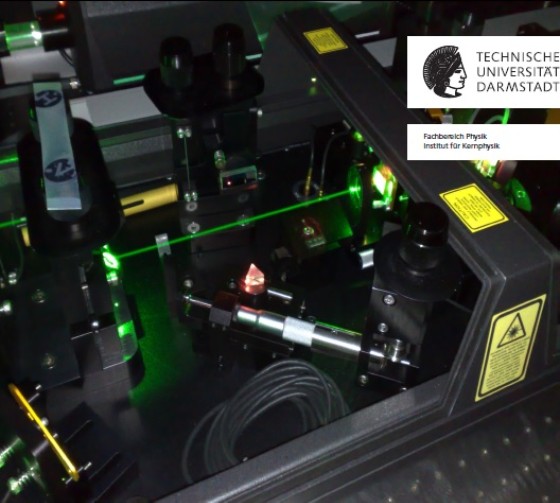Erzeugung und Untersuchung gepulster polarisierter Elektronenstrahlen am S-DALINAC
Production and investigation of pulsed polarized electron beams at the S-DALINAC
PhD thesis
For production and investigation of pulsed polarized electron beams at the superconducting accellerator S-DALINAC pulsed laser-systems with bunch lengths of smaller than 20 ps are required. These enable production of spin polarized electrons from GaAs semiconductors by photo-effect. Therefore the source of polarized electrons uses laser-diodes and a Titanium:Saphire-laser-system. While pulses from Titanium:Saphire-laser-system are generated by modelocking, the modulation of the two diode-laser-systems is based on direct coupling of high frequency. The minimal pulse length of two diode-laser-systems was measured to be 50 ps for the 780nm diode and 20 ps for the 415nm diode. On the other hand the Titanium:Saphirelaser-system delivers a pulse length of several hundreds femtoseconds.
A long term operation mode for the S-DALINAC polarized injector (Spin) is provided by the laser-diodes using continuous wave mode at the accelerator fundamental frequency of 3 GHz. The Titanium:Saphire-laser-system works at a repetition rate of 75MHz and causes on the contrary temperature dependent failures in the pulsed operation mode. This dissertation took investigations of changes in intrinsic laser paramters related to the temperature. Temperature stabilization of better than ±0,015 K over one week was achieved. Furthermore with soft aperture the stability of the modelocking could be increased. This effect has been simulated and proven experimentelly. Although the laser was temperatur stabilized, pulse length deviations of 200 fs to 330 fs were observed. It seems to be related to a correlation between laser pulse length and room temperature. This correlation probability is determined to be 81 %.
Furthermore, this work deals with the transport of ultra short laser pulses over a distance of approximately 40 m. A fiber with a length of about 50m was used and a coupling efficiency of smaller 40% was achieved. Here the bandwidth enlargement of the Titanium:Sapphire-laser up to 50nm as a function of intensity was determined. In this case the optical laser pulse with the length of (260±20) fs will be extended chromatically to (80±6) ps. By comparing of the theoretical calculations with measured spectral distribution conclusions about the degree of polarization of the extracted beam from the strained superlattice cathode could be made. Therefore an intensity-dependent behavior of the electron polarisation has been found. It depends on the laser power and on the center wavelength λ0. To reduce these effects a free laser beam transfer has been build up, too. By using a Piezo mirror and a developed feedback control system it was possible to achieve a positional accuracy of <10 µm at a control frequency of 2 Hz over 66 h at the location of the cathode.
For the first investigations of the structure of the generated electron bunches at the S-DALINAC at low electron energies the chopper system at the injector part of the accelerator has been used. With an additionally installed narrow slit the bunch length could be characterized with a resolution of (7,0±3,5) ps. Here, a phase jitter of the electron beam of 2,2 ps at a measuring time of 30 min was determined. Due to the run time differences of the laser beam during transfer, which are caused by the feedback control system, one more negligible jitter of 1,6 fs appeared. The measurements indicate an additional mode inside the chopper cavity. This changes the position of phase of the laser pulse with respect to the chopper state. This effect was measured with the 780nm laser-diode and to be between 30 ps and to 80 ps. From experimentel results, that was modeled and reproduced by a simulation, a genuine bunch length of (50,0±0,2) ps could be determined.
The measurements of the longitudinal (bunch length) and of the transverse (beam diameter) beam profile have shown space charge effects already at a bunch charge of 1 fC. To compensate the pulse broadening in the 50m long fiber, a pulse compressor was built. With the aid of it and the usage of a bulk GaAs photo-cathode the lengths of the electron bunch could be varied between 30 ps to 80 ps. In this measurement, the minimal resolution of the chopper-slit-method was confirmed.
The intensity and polarization of the electron bunches from a bulk- and a superlattice GaAs cathode were measured with good phase resolution using the chopper-slit-method. In the case of bulk cathode, an average polarization of (31,0±3,5)% and a peak polarization of (49,1±5,6)%was yielded, that agree well with the literature values. In the case of superlattice cathode an average polarization of only (38,4±4,4)% and a peak polarization of (65,7±7,5)% were achieved, that is significantly below established experienced data.
For the description of electron bunch characteristics from GaAs-cathodes the three-stage model of Spicer was used so far. Unfortunately this model does not adequately describe measured in this work data. Therefore the new modell that was developed in this work takes into account not only intensity deviations in the electron bunch but also can describe polarization changes. To enable this higher order of recombination terms for electron-hole pairs was needed. This model adds to the recombination rate (measured values for bulk GaAs) (1/A=(40±10) ps) of Spicer three-step model, the effect of optical recombination (B=(1±3)*10-10 cm3/s), Auger recombination (C=(5±2)*10-28 cm6/s) and the spin-flip term (1/K=(61,6±2) ps). The founded parameter for optical- and Auger recombination are in good agreement with literature values. However, a discrepancy in values for the parameters A and K have been seen. The difference could be caused by insufficient activation of a used cathode after previous damage by irradiation by intence laser light. With this model, predictions about the behavior of bulk GaAs cathode could be made, that promise the appearence of saturation effects and non-linear behavior at high carrier densities. It could be a matter of interest for many accelerator facilities with regard to high-current experiments.


